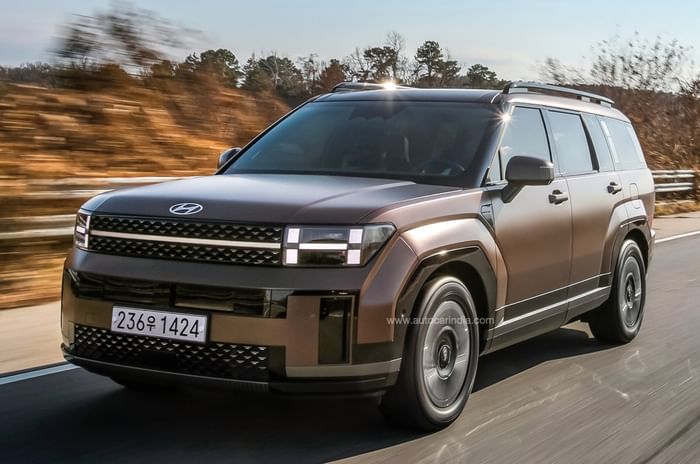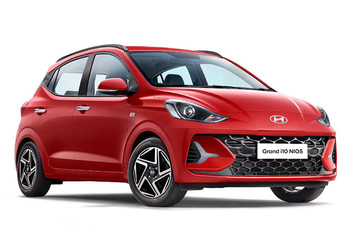Hyundai Santa Fe review: Style and substance
Santa Fe's luxurious cabin and boxy looks could help it make a case for itself in India.
Published on Dec 15, 2023 08:00:00 AM
31,387 Views
Follow us on


Rear seats sat at a height, but seat is a bit small.

Santa Fe gets twin wireless charging pads.
Hyundai says that it is unlikely to bring the new Santa Fe to India, but that doesn’t really come as a surprise. With pricing that matches luxury car levels, a mass market badge on the nose, and only space and roominess to play up as an advantage, Hyundai actually discontinued the Santa Fe in India after selling it here for two generations. But with the Ioniq 5 having sold 1,100 units and the Tucson getting more and more popular, is this a mistake on Hyundai’s part? Let’s take a closer look.

Hyundai Santa Fe exterior design
This new, more outdoors-oriented Santa Fe with its chunky look and more luxurious cabin is certainly more revolutionary than evolutionary. Although the new lines and fresh details impress, it seems like the design and concept stem from a blank sheet of paper rather than any previous Santa Fe. The nose is almost block-like, with ‘H’ pattern LED headlights – just like the Exter. It gets active vents that help it achieve an impressive drag coefficient of 0.29, and what also works well are the bulky and chamfered wheel arches.

In profile you also see plenty of elements that are similar to the Land Rover Defender. This is especially true of the blacked-out pillars and the ‘floating’ roof finished in body colour. Interestingly, there’s a step hidden inside the pillar, right above the rear tyre, so you can easily climb up and clean the roof. Wonder if you can store a micro fibre cloth? While the nose and the profile work pretty well, walk around to the rear of the SUV and the Santa Fe has a very van-like treatment. Yes, the simplicity of the design works from afar, however, get closer and the oversized logo, model name and block-like design don’t really impress.
Hyundai Santa Fe interior
On the inside, most versions of the Santa Fe come with up to three rows of seats, but the 1.6 hybrid we are driving gets only two. While the cabin is extremely long, it isn’t very wide. The look and feel of the dash also borrows heavily from Land Rover and Range Rover. The steering, in fact, looks like it could have come directly from a Land Rover parts bin, and this is also true of the treatment of the top of the dash and the glovebox.

What’s clear, however, is that the cabin works; it’s comfortable, quality levels are good and like all Hyundais, the Santa Fe comes with plenty of comfort enhancing, clever and cool features. The driver’s seat is easily adjustable and while the quality of the steering can’t quite match that of the original, the dash is beautifully built and material quality is good enough to make this one of the nicest Hyundai’s I’ve been in. I particularly like the raised and boxed in central console with its twin charging pads. There’s also loads of storage, both above and below the central console, and what I especially like is the beautifully curved instrument panel and touchscreen, which is perfectly angled for the driver. The second row seats are also comfortable. Set at a height with theatre seating, the view out and back support is good, and while the bench could have been more accommodating and longer in squab, it is a comfortable place to be. The boot opening is wide too and easy to load and load up.
Hyundai Santa Fe driving
The Santa Fe is an extremely relaxing car to drive. Part of this is down to the position of the driver’s seat: the view out and how easy it is to access the steering wheel. What also works well is the fact that the controls are nicely weighted and the electric boost from the hybrid system makes taking off from rest feel effortless.
 Steering is very similar to Land Rover design.
Steering is very similar to Land Rover design.The strong hybrid system that powered the Santa Fe we were driving blends a 1.6-litre turbo-petrol engine with an electric motor. With 180hp and 265Nm of torque, this front-wheel drive version pulls forward comfortably at most speeds. Performance isn’t electrifying, pun intended, and this isn’t an SUV for those interested in speed and performance.
While initial responses and acceleration are good, the 1.6 hybrid can’t sustain the thrust as you pull it harder. Sure, power delivery when the turbo chimes in is good, but keep your foot down after and performance flattens out, and the engine sounds strained. While gearshifts are smooth and imperceptible for the most part, acceleration is only good for a 0-100 time of 9.5 seconds, not something to write home about.
 Gear selector has a nice chrome finish.
Gear selector has a nice chrome finish. The Santa Fe is also not an SUV that likes to be hustled. The tall stance, relatively narrow track and long wheelbase mean you need to use progressively more lock on tighter corners; drive it hard and it’s clear you are giving the chassis too much to do. Ride quality, however, is pretty good, with it being supple and soft initially and soaking up most bad sections nicely. There is a bit of up and down movement at speed, and sharp edged-bumps do register with a thud.
Hyundai Santa Fe verdict

On the face of it this looks like the perfect SUV for India: big, comfy, available with an efficient hybrid powertrain, a unique identity, looks that are appealing and a genuinely nice cabin. Yes, more performance would have been nice and it doesn’t have a sporty bone in its body, but this isn’t a car you buy to howl around corners in. So while on the one hand you could look at the seven-seater version as a left field alternative to something like a Toyota Fortuner, are Indian car buyers ready to pay upwards of Rs 50 Lakh for a Hyundai? On the basis of how well the Hyundai Tucson and Ioniq 5 are doing, the answer could be yes.
Tech Specs 
Copyright (c) Autocar India. All rights reserved.














 Price
Price Engine
Engine Transmission
Transmission Acceleration
Acceleration Body
Body Dimensions
Dimensions
Comments
Member Login
Personal Details
No comments yet. Be the first to comment.